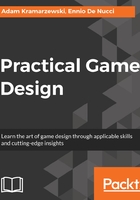
Responsibilities of a game designer
The tasks and responsibilities of a game designer vary dramatically and are affected by the team structure, project type, and the development phase.
To shed some light on what you might be required to do, let's look at a real-world example. Here is a list of tasks I undertook when working with a mid-sized team at a London studio, Space Ape games, on a mobile game, Transformers: Earth Wars. The game could be classified as a part of the Build & Battle genre—similar to Clash of Clans, but with a multitude of unique characters, all with their own attacks and abilities.
In the two and a half year period (one year to soft launch, half a year to polish the game, and a year of live operations), my tasks included:
- Writing the GDD (game design document) and most of the subsequent feature specs (smaller documents explaining game features and content required).
- Communicating the design vision (face to face, and in writing) and overseeing the implementation of game mechanics, features, and content.
- Creating user flows and sketching user interface designs.
- Prototyping, designing, and implementing new gameplay systems and content including characters (with varied classes, stats, behaviors, weapons, and special abilities), game modes, achievements, buildings, and defenses.
- Level design and creation of single-player campaigns.
- Planning, scripting, and tweaking tutorials, achievements, and cutscenes.
- Balancing gameplay with dozens of special abilities and over 100 unique characters.
- Writing and integrating in-game text and dialog.
- Requesting and integrating new VFX. Over time, I also started doing more and more particle effects on my own by tweaking and combining existing ones (thus enabling that artist to work on other games).
- Planning a future content roadmap: new characters, game features, and story developments.
- Managing an external writer and audio engineer, creating a list of tasks for them, feeding back on their work, and integrating it.
- Addressing the community via weekly Twitch Live Streams, YouTube videos, Q&As, and more.
Now, this sure sounds like a lot to handle! Fortunately, I had another senior designer working with me during the first year of development. We also had the entire game economy handled by our monetization specialist. This included setting up and fine-tuning the income and spending of in-game currency, level up and upgrade curves, building timers, in-app purchases, and more. We also had a live operations expert who joined later and took care of our weekly special events, in-app purchase promotions and content rollout. All of these tasks can, and often will also fall on the game designer.
Do not worry though! Throughout this book, we'll shed light on these confusing terms and technical jargon, and build an understanding of how to approach your daily tasks as a game designer! First up, how are game projects run?